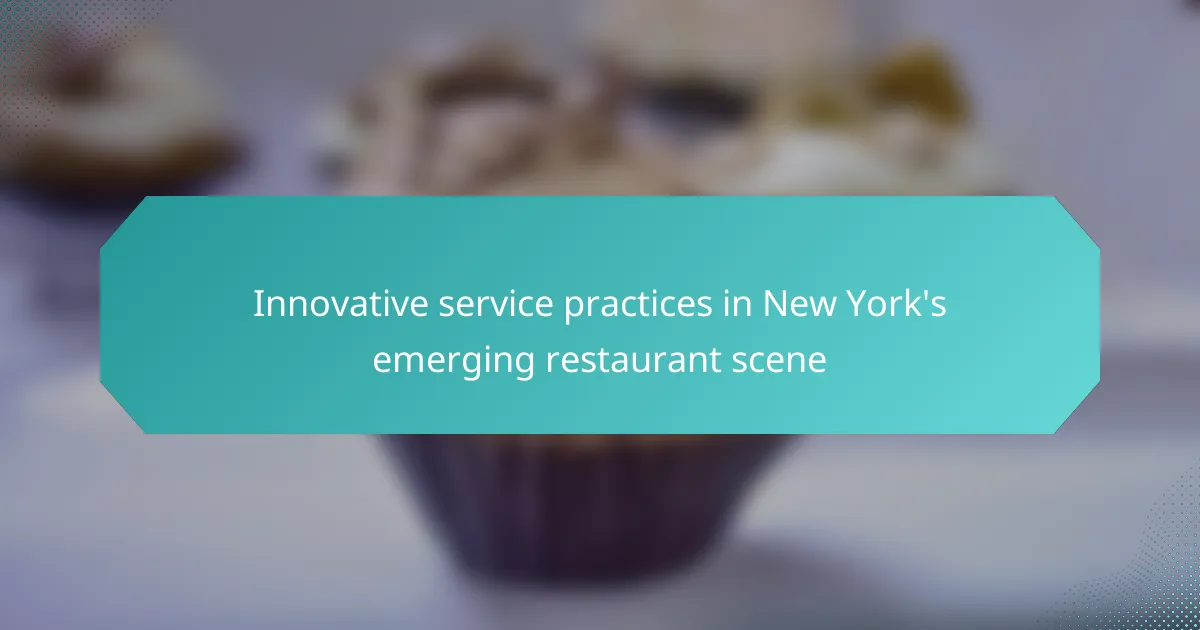The article examines innovative service practices within New York’s emerging restaurant scene, focusing on personalized dining experiences, technology integration, and sustainability initiatives. Key practices include customized menus based on guest preferences, mobile apps for reservations and ordering, and contactless payment options that enhance convenience and safety. Additionally, the use of data analytics allows restaurants to better understand customer behavior, leading to tailored services and improved operational efficiency. The integration of virtual reality for immersive dining experiences is also highlighted as a growing trend. Overall, these innovations reflect a shift towards more engaging and efficient service models in the restaurant industry.

What are innovative service practices in New York’s emerging restaurant scene?
Innovative service practices in New York’s emerging restaurant scene include personalized dining experiences and technology integration. Many restaurants now offer customized menus based on guest preferences. This approach enhances customer satisfaction and loyalty. Additionally, the use of mobile apps for reservations and ordering streamlines the dining process. Contactless payment options have also gained popularity, promoting safety and convenience. Restaurants are increasingly using data analytics to understand customer behavior. This helps in tailoring services and improving operational efficiency. The integration of virtual reality for immersive dining experiences is also on the rise. Such practices reflect a shift towards more engaging and efficient service models in the restaurant industry.
How are these practices reshaping customer experiences?
Innovative service practices are reshaping customer experiences by enhancing personalization and efficiency. Restaurants in New York are adopting technology-driven solutions. These include mobile ordering systems and contactless payments. Such practices reduce wait times and streamline service. Customers benefit from tailored recommendations based on their preferences. Enhanced customer engagement is achieved through interactive dining experiences. Data analytics allows restaurants to understand customer behavior better. This leads to improved menu offerings and service adjustments. Overall, these practices create a more satisfying and memorable dining experience.
What specific elements contribute to enhanced customer satisfaction?
Enhanced customer satisfaction is influenced by several specific elements. Key elements include quality of service, food quality, and ambiance. Quality of service involves staff attentiveness and responsiveness. Food quality encompasses taste, presentation, and freshness. Ambiance relates to the restaurant’s atmosphere, including decor and noise levels.
Research indicates that 70% of customers cite service quality as a primary factor in their satisfaction (American Express). Additionally, 60% of diners consider food quality crucial to their experience (National Restaurant Association). A well-designed ambiance can increase customer retention by 30% (Restaurant Hospitality). These elements collectively create a memorable dining experience, leading to higher customer satisfaction.
How do these practices influence repeat business and customer loyalty?
Innovative service practices significantly enhance repeat business and customer loyalty. These practices create memorable dining experiences. A positive atmosphere encourages customers to return. Personalization in service fosters emotional connections. When customers feel valued, they are more likely to become loyal patrons. Research shows that 70% of consumers are more likely to return if they receive personalized service. Additionally, restaurants that implement unique service elements often see a 20% increase in repeat visits. Thus, effective service practices are crucial for building long-term customer relationships.
Why is innovation crucial in New York’s restaurant industry?
Innovation is crucial in New York’s restaurant industry to stay competitive and meet evolving consumer demands. The industry faces intense competition with thousands of dining options available. Restaurants must differentiate themselves to attract customers. Innovative practices can include unique menu offerings, technology integration, and sustainable sourcing. For example, the rise of plant-based menus has catered to health-conscious diners. Additionally, technology like online reservations and delivery apps enhances customer convenience. According to a 2022 report by the New York State Restaurant Association, 70% of diners prefer restaurants that offer innovative dining experiences. This data underscores the need for continuous innovation in the industry.
What challenges do restaurants face that drive the need for innovative practices?
Restaurants face several challenges that necessitate innovative practices. Competition in the food industry is fierce, with numerous options available to consumers. According to the National Restaurant Association, over 1 million restaurant locations exist in the U.S. alone. This saturation drives restaurants to differentiate themselves through unique offerings.
Labor shortages also pose significant challenges. A report by the U.S. Bureau of Labor Statistics indicates a high turnover rate in the restaurant sector, often exceeding 70%. This situation compels restaurants to streamline operations and adopt technology to enhance efficiency.
Additionally, changing consumer preferences require adaptability. A survey by Technomic shows that 60% of diners prefer healthier and sustainable options. Restaurants must innovate their menus and sourcing practices to meet these demands.
Economic pressures, such as rising food costs and inflation, further drive the need for innovation. The Consumer Price Index indicates food prices have increased significantly in recent years. Restaurants are thus compelled to implement cost-effective practices while maintaining quality.
Lastly, the impact of the COVID-19 pandemic has transformed dining experiences. Many restaurants are now focusing on takeout and delivery options, necessitating changes in service models. These challenges collectively drive the need for innovative practices in the restaurant industry.
How does competition in New York’s dining landscape impact service innovation?
Competition in New York’s dining landscape drives significant service innovation. Restaurants continually seek to differentiate themselves to attract customers. This leads to the adoption of new technologies, such as mobile ordering and contactless payments. Additionally, many establishments enhance customer experiences through personalized service and unique dining concepts. For instance, the rise of experiential dining showcases how restaurants innovate to create memorable experiences. According to a 2022 report by the New York Restaurant Association, 70% of restaurant owners noted that competition pushed them to innovate their service offerings. This competitive environment fosters a culture of creativity and adaptation, essential for success in the vibrant New York dining scene.

What types of innovative service practices are being implemented?
Innovative service practices in New York’s emerging restaurant scene include personalized dining experiences, technology integration, and sustainability initiatives. Personalized dining experiences involve tailored menus and customer interactions. Technology integration encompasses mobile ordering, contactless payments, and digital reservations. Sustainability initiatives focus on sourcing local ingredients and reducing food waste. These practices enhance customer satisfaction and operational efficiency. They also reflect current trends in consumer preferences and environmental consciousness.
How do technology-driven solutions enhance service delivery?
Technology-driven solutions enhance service delivery by streamlining operations and improving customer experience. These solutions include online ordering systems, reservation platforms, and contactless payments. They enable restaurants to reduce wait times and optimize staff allocation. For instance, a study by Toast in 2021 found that 70% of diners prefer online ordering for its convenience. Additionally, data analytics tools help restaurants understand customer preferences and adjust menus accordingly. This targeted approach increases customer satisfaction and loyalty. Furthermore, technology facilitates real-time communication between staff and customers, improving service efficiency. Overall, these innovations lead to enhanced operational effectiveness and better dining experiences.
What role does mobile ordering play in the dining experience?
Mobile ordering enhances the dining experience by providing convenience and efficiency. Customers can place orders from their smartphones before arriving at the restaurant. This reduces wait times and allows for a more seamless dining experience. Studies show that 70% of consumers prefer mobile ordering for its speed. Additionally, mobile ordering often includes features like customization and payment options. Such features cater to individual preferences and streamline the ordering process. The integration of mobile ordering in restaurants reflects a growing trend in the industry. This trend aligns with consumer demand for technology-driven solutions in dining.
How are contactless payments changing customer interactions?
Contactless payments are transforming customer interactions by streamlining the transaction process. They allow customers to pay quickly without physical contact. This efficiency enhances the overall dining experience. A study by the National Restaurant Association found that 56% of consumers prefer contactless payments for their convenience. Additionally, contactless payments reduce wait times, which improves customer satisfaction. Restaurants adopting this technology can cater to a tech-savvy clientele. The rise of mobile wallets further supports this trend, with over 40% of consumers using them regularly. Overall, contactless payments foster a faster, safer, and more enjoyable dining environment.
What unique service models are emerging in New York restaurants?
Unique service models emerging in New York restaurants include ghost kitchens, which operate without a physical dining space. These kitchens focus solely on delivery and takeout, reducing overhead costs. Another model is hybrid dining, combining traditional sit-down service with fast-casual options. This allows restaurants to cater to a wider range of customer preferences. Subscription dining services are also gaining traction, offering customers regular meal deliveries for a fixed fee. Additionally, some restaurants are implementing technology-driven service, such as QR code menus and contactless payments, enhancing the customer experience. These models reflect a shift towards convenience and efficiency in the dining industry.
How does the farm-to-table approach affect service practices?
The farm-to-table approach significantly impacts service practices by emphasizing fresh, locally sourced ingredients. Restaurants adopting this model often adjust their menus based on seasonal availability. This results in a dynamic menu that changes frequently, requiring staff to be knowledgeable about ingredient sourcing.
Service staff must communicate effectively with customers about the origin of dishes. This enhances the dining experience by connecting patrons to local farms and producers. Additionally, the farm-to-table model fosters relationships with local suppliers, which can improve service efficiency.
Research indicates that restaurants using farm-to-table practices often report higher customer satisfaction rates. A study by the National Restaurant Association shows that 70% of consumers are more likely to visit a restaurant that offers locally sourced foods.
What is the impact of experiential dining on customer engagement?
Experiential dining significantly enhances customer engagement. It creates memorable interactions between diners and the restaurant environment. This form of dining often involves unique themes, interactive elements, and personalized services. Such experiences encourage customers to share their stories on social media. Research shows that 70% of diners are more likely to return after a memorable experience. Additionally, experiential dining can increase customer loyalty and word-of-mouth referrals. Engaging elements like chef interactions and immersive atmospheres lead to higher satisfaction rates. This engagement can translate into increased revenue for restaurants.

How do these innovative practices affect restaurant operations?
Innovative practices significantly enhance restaurant operations. They improve efficiency through streamlined processes. For instance, technology integration allows for faster order processing. This reduces wait times for customers. Enhanced customer experience leads to increased satisfaction. Data analytics helps restaurants understand customer preferences better. This can result in tailored menu offerings. Additionally, sustainable practices can lower operational costs. Implementing these innovations can lead to higher profit margins. Overall, these practices create a more agile and responsive restaurant environment.
What are the key operational changes driven by these practices?
Key operational changes driven by innovative service practices include enhanced customer engagement and streamlined processes. Restaurants are adopting technology to improve order accuracy and speed. Digital menus and contactless payments are becoming standard. Staff training is focused on personalized service to meet evolving customer expectations. Data analytics is being utilized to optimize inventory management and reduce waste. These changes result in increased efficiency and customer satisfaction. According to the National Restaurant Association, 70% of restaurants report improved operations through technology adoption.
How do staff training and development adapt to new service models?
Staff training and development adapt to new service models by integrating technology and flexible learning approaches. Training programs now emphasize digital tools and platforms for remote learning. This shift allows staff to access training materials anytime, enhancing knowledge retention. Additionally, role-specific training is tailored to meet the demands of new service models. For example, staff may receive training on contactless service techniques in response to health guidelines. Continuous feedback mechanisms are also implemented to refine training processes. Research indicates that 70% of employees prefer learning at their own pace, supporting the need for adaptable training solutions. Such strategies ensure that staff remain competent and responsive to evolving service expectations.
What impact do these innovations have on kitchen operations?
Innovations in kitchen operations streamline processes and enhance efficiency. These advancements reduce food preparation time significantly. For example, automated cooking equipment can decrease cooking time by up to 30%. Innovations also improve food consistency and quality, ensuring dishes meet customer expectations. Additionally, smart inventory management systems minimize food waste by tracking stock levels accurately. This leads to cost savings for restaurants. Furthermore, technology integration allows for better communication among kitchen staff, fostering teamwork. Overall, these innovations transform traditional kitchen operations into more efficient, sustainable practices.
What are the best practices for implementing innovative service practices?
The best practices for implementing innovative service practices include fostering a culture of creativity, investing in staff training, and utilizing technology effectively. A culture of creativity encourages employees to share ideas and experiment with new approaches. Staff training ensures that team members are equipped with the necessary skills to deliver innovative services. Utilizing technology, such as reservation systems and customer feedback tools, enhances efficiency and customer experience. Research indicates that restaurants adopting these practices see improved customer satisfaction and operational efficiency. For instance, a study by the National Restaurant Association found that technology adoption can increase sales by up to 20%.
How can restaurants effectively measure the success of new service strategies?
Restaurants can effectively measure the success of new service strategies by analyzing customer feedback and sales data. Customer feedback can be gathered through surveys and online reviews. This data provides insights into customer satisfaction and areas for improvement. Sales data can indicate changes in revenue and average transaction values. Comparing these metrics before and after implementing new strategies shows their impact. Additionally, monitoring staff performance and training effectiveness contributes to understanding service quality. Industry benchmarks can also serve as a reference point for evaluating success. Implementing these measures allows restaurants to adapt and refine their service strategies effectively.
What tips can restaurant owners follow to foster a culture of innovation?
Restaurant owners can foster a culture of innovation by encouraging collaboration among staff. This can lead to the sharing of creative ideas and solutions. Providing training opportunities enhances skills and inspires new approaches. Implementing a feedback system allows employees to voice suggestions and improvements. Creating a safe environment for risk-taking promotes experimentation without fear of failure. Establishing partnerships with local farms or artisans can introduce unique ingredients and concepts. Regularly hosting brainstorming sessions can stimulate innovative thinking. Lastly, staying updated on industry trends helps owners adapt and innovate effectively.
Innovative service practices in New York’s emerging restaurant scene focus on personalized dining experiences, technology integration, and sustainability initiatives. Key elements contributing to enhanced customer satisfaction include quality of service, food quality, and ambiance. These practices reshape customer experiences by utilizing mobile ordering, contactless payments, and data analytics to tailor services. Additionally, the competitive landscape drives restaurants to adopt unique service models, such as ghost kitchens and experiential dining, to differentiate themselves and meet evolving consumer demands. Overall, these innovations significantly impact operational efficiency and customer loyalty in the restaurant industry.
